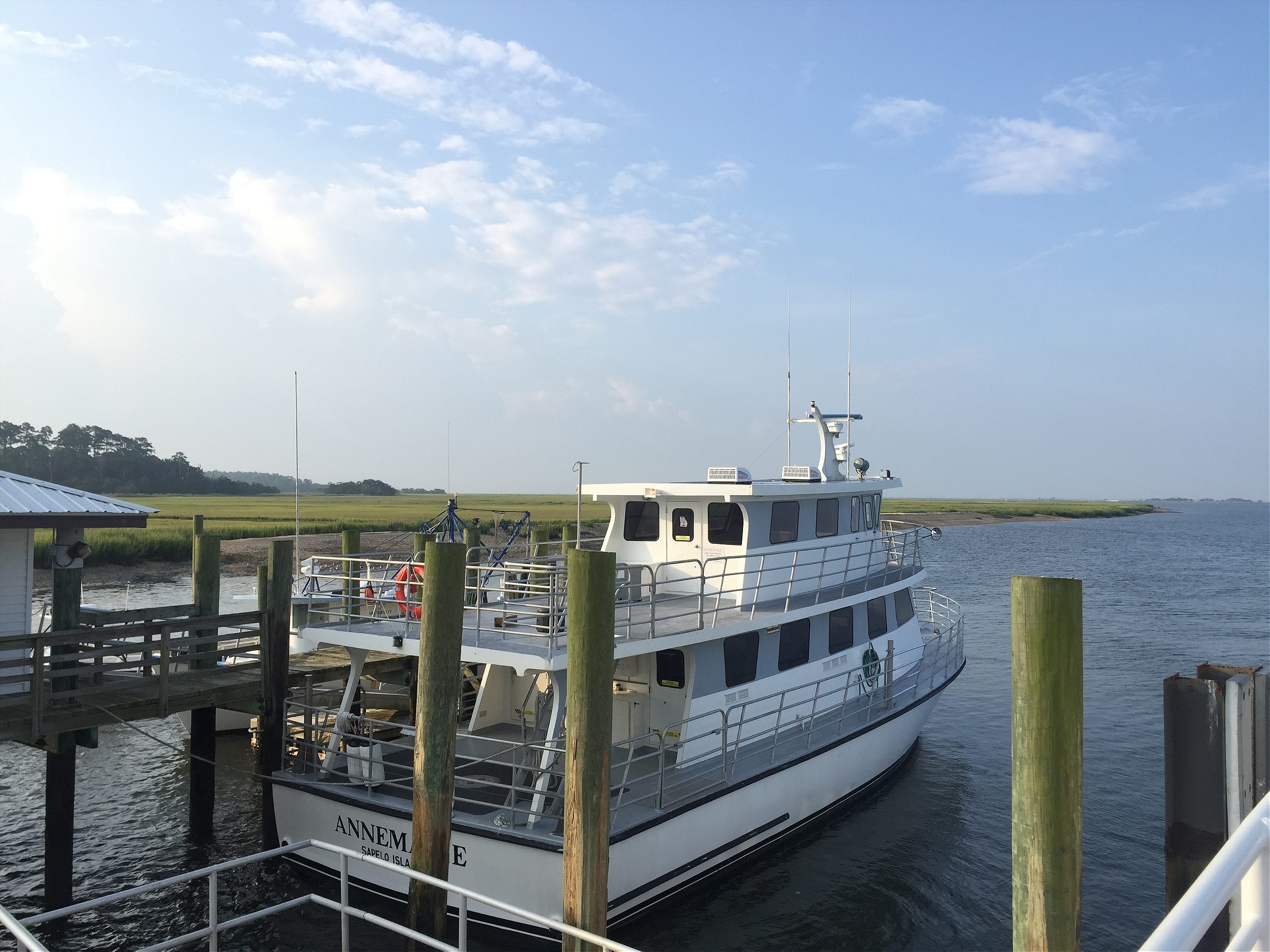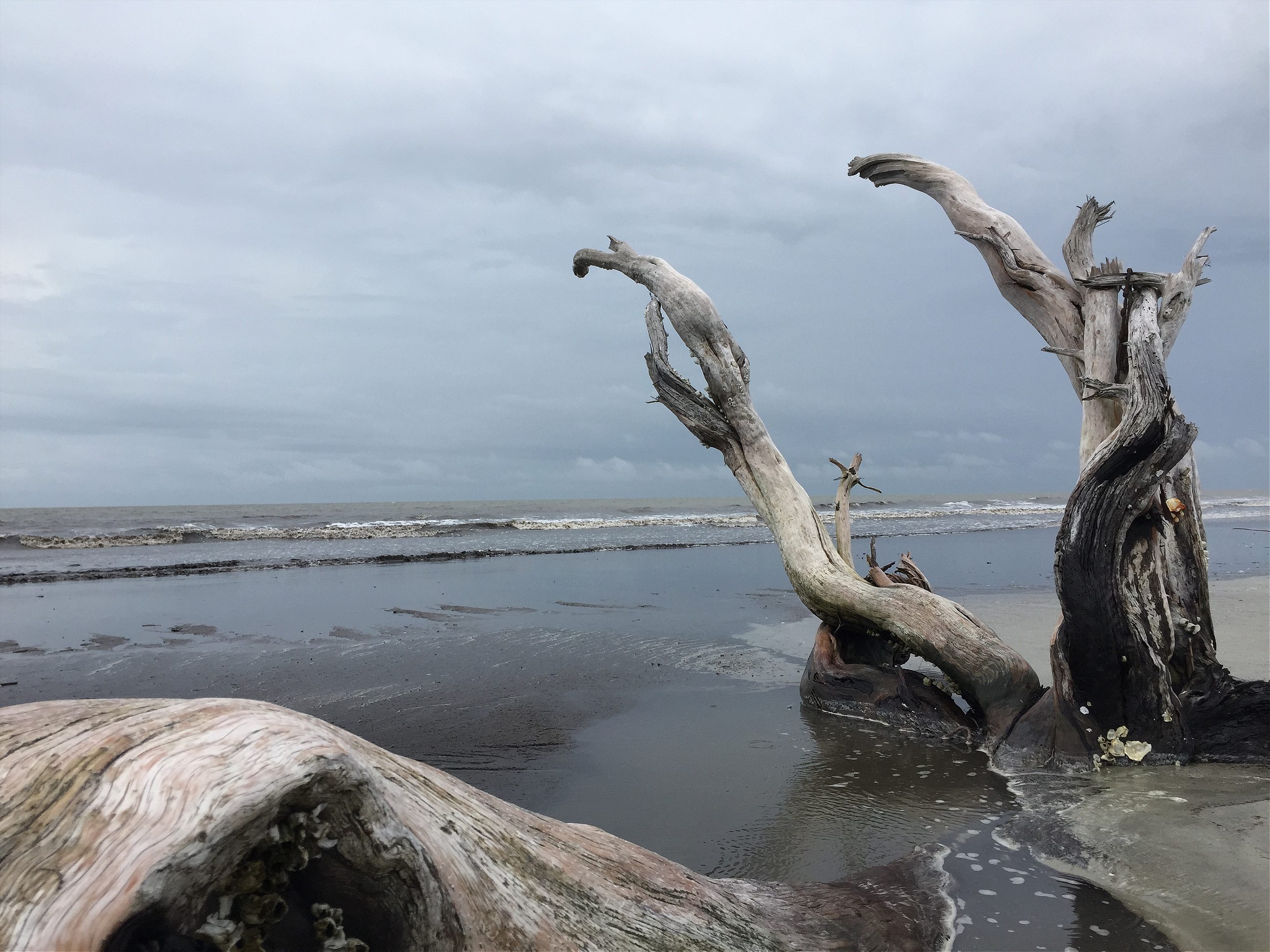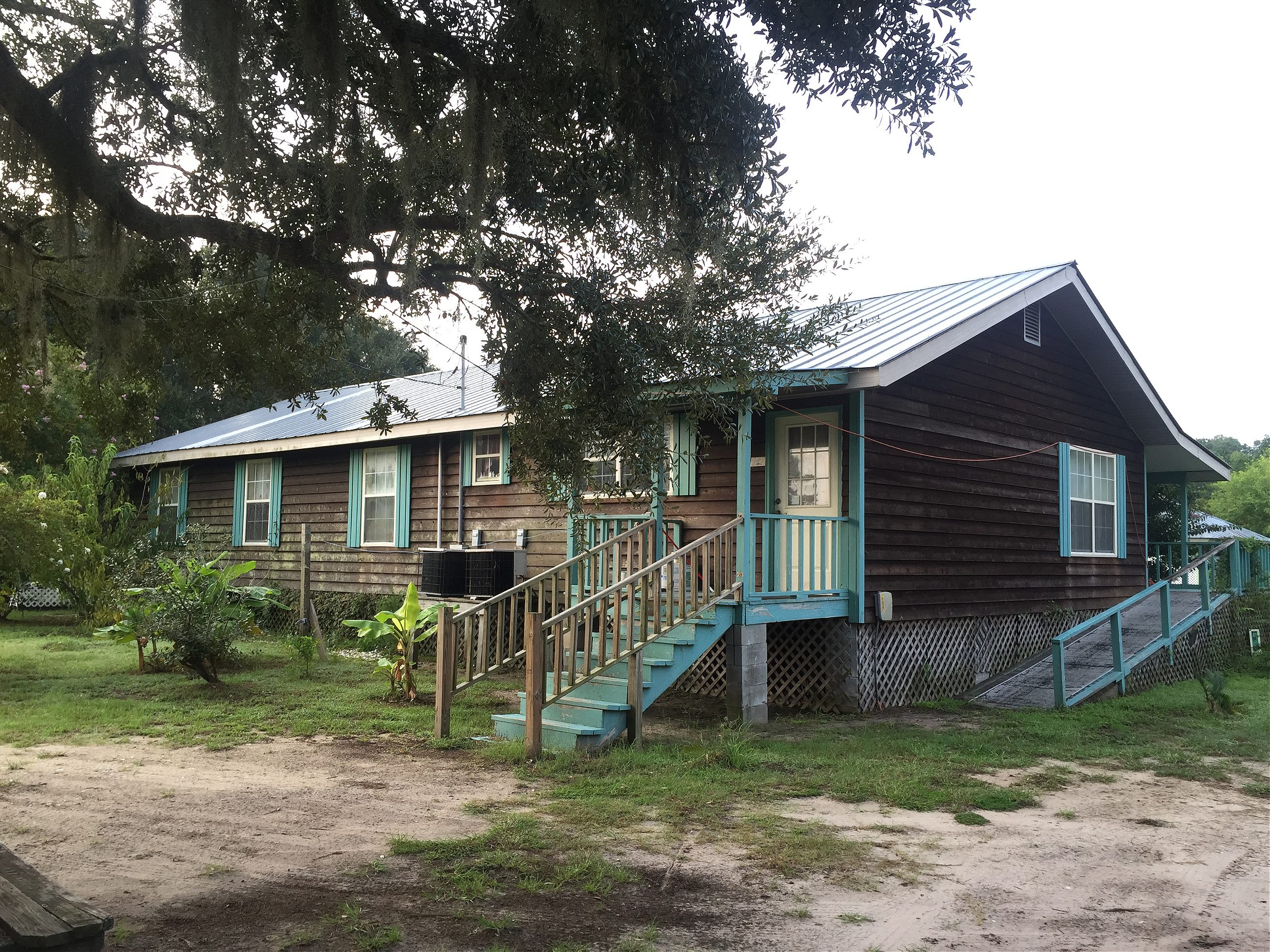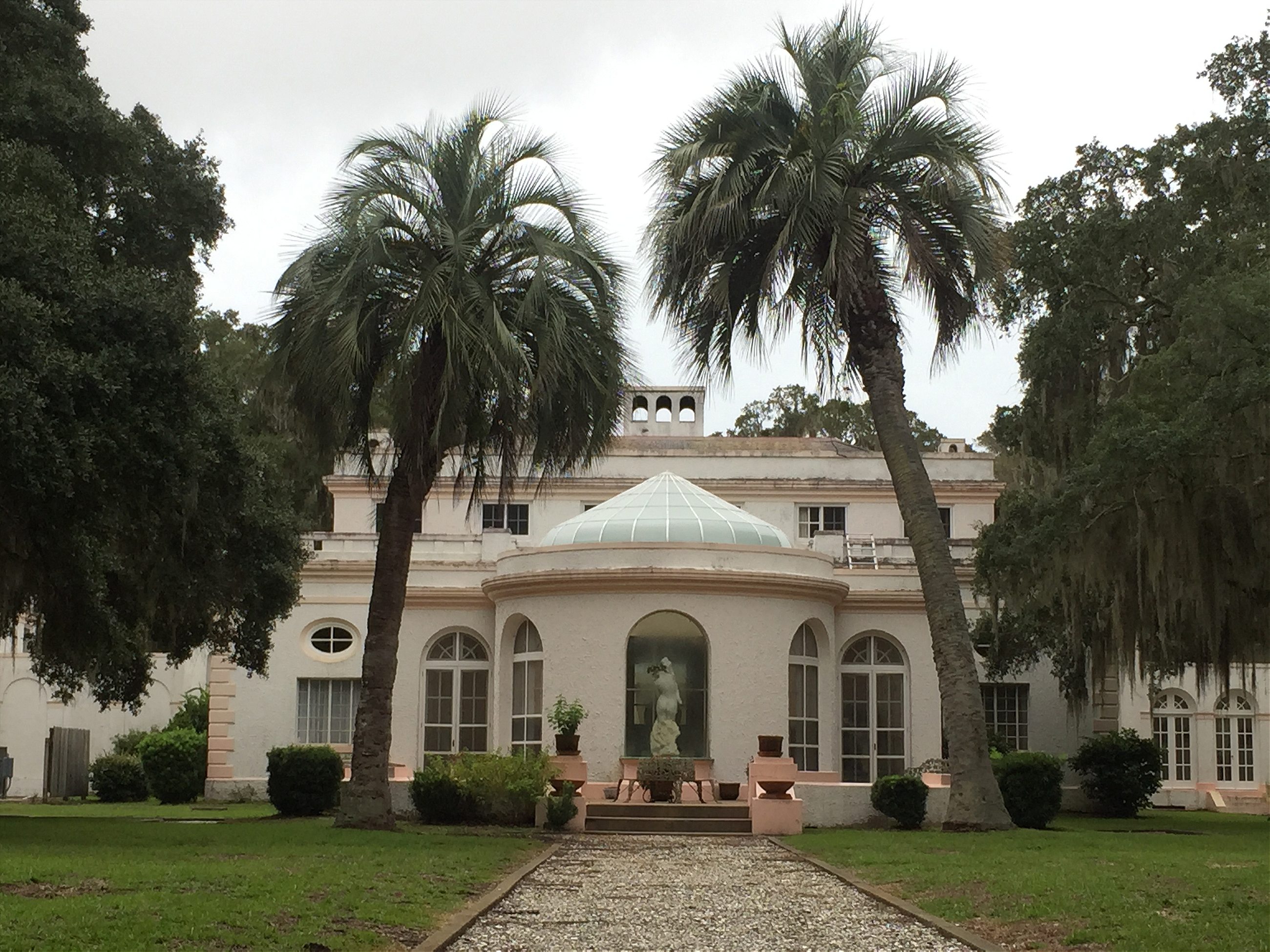The last intact Geechee community fights for survival on Georgia’s coast.
At 16,500 acres of salt marsh, sand, tidal creeks, and maritime and pine forests, Sapelo is the fourth largest of Georgia’s barrier islands. On a map, it’s south of Savannah, smack in the center of the state’s incurvate coastline, a position that keeps it relatively sheltered during hurricane season. The few people still residing on Sapelo Island pass down accounts of the last major storm, in 1898, which waterlogged the red-and-white-banded lighthouse on the South End. The lighthouse has since been restored and functions as an unmanned tourist attraction, sprouting from a patch of tall grass fronted by Doboy Sound.
Getting to the island isn’t easy. The state of Georgia owns 97 percent of Sapelo and limits access to residents and approved visitors—usually day-trippers booked on state-guided tours—who travel on a passenger ferry between the tiny mainland town of Meridian and Sapelo’s only dock, Marsh Landing. The ferry is named for the island’s last midwife, Katie Underwood.

Parked cars edge the road extending from Marsh Landing. They straddle pavement and grass like their owners hopped out to attend a high-school football game. According to Island Manager Fred Hay, the vehicles belong to part-time residents of Sapelo—those who come on weekends and some who only visit a few times a year. This is one of only a few paved roads that snake around the South End, where the Georgia Department of Natural Resources and the University of Georgia Marine Institute operate. Pocked dirt roads vein the rest of the island. When they navigate the roughest territory, residents and state employees rely on supplies stowed in their truck beds: shotguns to kill the wild hogs that are destroying the North End ecosystem and sturdy ropes to clear fallen trees or tow a friend’s car out of the mud. The main paved roads, the North-South Autobahn and the East-West Autobahn, meet in the center of the island’s South End, at the western edge of Hog Hammock, the only intact Geechee community remaining in the country.
The Geechee—or Gullah—are descendants of West Africans carried across the Atlantic and through the port cities of Charleston and Savannah, where they were purchased as slaves by tidewater planters in Georgia and the Carolinas. The coastal lands extending from Wilmington, North Carolina, to present-day Jacksonville, Florida, were both fertile and remote. Communities of slaves in Georgia and the Carolinas spoke a creole language rooted in English but peppered with African words, speech patterns and rhythms. They maintained traditions from their homelands, weaving sweetgrass baskets using techniques established by West African rice planters, and infusing Muslim and African customs into Christian ceremonies.

Collectively, the descendants of these slave communities are called Gullah-Geechee; though most often Gullah refers to groups living in North and South Carolina, and Geechee encompasses those in Georgia and Florida. The Geechee of Hog Hammock can trace their heritage back to slaves purchased by a handful of white landowners, the most prolific of whom was Thomas Spalding. By the time of his death in 1851, Spalding owned more than 350 slaves.
The 434-acre neighborhood of Hog Hammock is composed of oddly delineated private tracts, two Baptist churches, a public library, a general store and bar, and several community buildings. A green and white sign stands at each entry point declaring the district’s acreage and population: 70. It’s one of the only signs on the island, but it’s misleading. The population has been dwindling for years and now stands at 38 full time residents.
Hog Hammock was my destination when I boarded the Katie Underwood on a Tuesday morning in early September. I was staying at the Wallow, an inn owned and operated by Julius and Cornelia Bailey. It’s next to their home in the center of the community. Both grew up on Sapelo and have been instrumental in raising awareness about the island’s dying Geechee culture. A published author and historian, Cornelia has been called the matriarch of the island. “When things happen, I’m the one they call or come seeking,” she told me.

In 1993 she founded the Sapelo Island Cultural and Revitalization Society, or SICARS, a nonprofit organization that works to preserve Geechee culture on the island. She now serves as the group’s vice president. Her husband Julius, who is called Frank by his friends and family, runs the island’s only bar, The Trough, and an adjoining general store. He also drives the school bus, which carries the island children, including three of the Baileys’ grandchildren, to and from the ferry. Fewer than 10 kids live on the island. Those old enough to attend school on the mainland ride the ferry to Meridian each morning. There hasn’t been a school on Sapelo in nearly four decades.
The media loves the Baileys, particularly Cornelia, who is 70 and wears her white hair cut short. She is tall, and when she straightens herself at the head of her kitchen table, she’s presidential. A sleek pair of black glasses usually rests on her high cheekbones. A writer herself, she’s an empathetic and gracious interview subject, but neither she nor her husband relish the spotlight. They put up with it to make sure the world doesn’t forget about Sapelo’s Geechee people.
The last big wave of journalists came in 2012, after a McIntosh County tax assessment increased land values and property taxes, in some cases by almost 600 percent. Because only three percent of the island is privately owned, developable land is limited to that which has historically belonged to the Geechee. This land is some of the most desired in the Southeast. Developers have scooped up whatever they can, buying out Geechee families and constructing vacation homes for predominantly white mainlanders.
Before the recession, descendants could sell undeveloped $15,000 lots for $100,000. Developers turned their investments around for two or three times that.
Geechee core values are rooted in an agricultural lifestyle that fails to translate anywhere else in this country
The county argued that all this activity drove up land values in Hog Hammock and claimed improved services compounded the tax increases. Residents looked around at their dirt roads, their lack of police or emergency services and their dilapidated senior center, and begged to differ. Facing the threat of being taxed out of their homes, they appealed to maintain the previous rates. The residents won, but they don’t know how long the lower rates will stick.
To be Geechee is to be tied to the southeastern lowcountry. The characteristics of the culture that have survived the modern world—entrepreneurialism, faith, a fierce reliance on family and community—seem applicable to any back-road American town; but for the Geechee, these core values are rooted in an agricultural lifestyle that fails to translate anywhere else in this country.
The culture grew out of a dependence on land, largely because of the lowcountry’s similarity to parts of West Africa. When Africans were brought to Sapelo as slaves, the wetlands and beaches and soil so resembled their homeland that perpetuating their farming, fishing and lifestyle methods not only staved off nostalgia, it was practical. Even today, kids grow up knowing how to crab, fish with cast nets and spot water moccasins. Community gatherings feature traditional island foods such as pork, sweet clams, oysters, fish, corn, sweet potatoes, tomatoes and red peas.
“You have to educate your own people to hold onto the heritage and the culture and the history, because without the land, you ain’t got it,” Bailey told me. “You can’t carry this culture in the middle of Chicago. It doesn’t work.” Through SICARS, Bailey is working to ensure descendants can keep their land in Hog Hammock. The organization has even helped some residents pay their property taxes.

After the Civil War, coastal land was majority black-owned. During Reconstruction, freed men bought the lands they’d lived and worked on, establishing permanent agricultural settlements that facilitated a continuation of Gullah and Geechee ways of life. The barrier islands were difficult to access, and though some of the nation’s wealthiest purchased parcels as recreational retreats in the early 20th century, much of the tidewater region remained under black ownership until the 1950s, when coastal capitalism gained momentum. Development took off, as did infrastructure, with shiny new bridges that democratized beach access. Caravans of wealthy white people headed for the shore. And under the institutional discrimination of Jim Crow, local black communities were intimidated and priced out of their only asset: land.
But the displacement of the Geechee people has happened more slowly on Sapelo. The island has never known the tourism and development of its coastal neighbors. Possibly the Great Depression prevented the growth that came to characterize the barrier islands. Howard Coffin, the automobile tycoon who turned Saint Simons and Sea Island into resort destinations, owned most of Sapelo from 1912 until 1934, when financial setbacks forced him to sell to tobacco heir R. J. Reynolds. What might have become a luxury vacation destination under Coffin evolved into a hunting preserve, wildlife refuge and marine research center under Reynolds. At the time of his purchase, five Geechee communities existed on the island. By Reynolds’ death, in 1964, he had forced the groups to consolidate in Hog Hammock.
In her memoir, God, Dr. Buzzard, and the Bolito Man, Cornelia Bailey recalls that her father, Hicks Walker, who worked for Reynolds, ultimately decided to move his family out of Belle Marsh, where he’d lived since birth. The island manager at the time offered incentives, first. “When that didn’t work, Cap’n Frank said, ‘Well, Hicks, you know it’d be too bad if you lose your job and have to go to the mainland and your family have to fend for themselves.’”
Reynolds controlled all of the jobs on Sapelo. What he couldn’t acquire through purchases or land swaps he got through intimidation. The state’s ownership of such stolen lands remains a point of contention on the island.
“It’s hard for people like you and me to understand what it was like in the 40s and 50s on this island,” Fred Hay told me. “You had a community of people who were one of the most marginalized groups in the country living down the road from one of the wealthiest men in America.” Hay picked me up from the Wallow one morning at 6:15 sharp, when the island was still dark. He doesn’t usually begin work at that hour, but on this morning he was running breakfast up to Chocolate Plantation, a house and collection of tabby ruins on the North End, where a group of state employees was holding a multi-day conference.

Hay began his career on Sapelo in 1993 as the education coordinator, a role he never quite shed when he stepped into the island manager position in 2004. He spends a lot of his free time outdoors. He comes alive pointing out the island’s longleaf pines, and he interrupts himself mid-thought when he spots something cool—the morning star, a devil’s walking stick.
Hay told me he wasn’t sure there was a modern parallel to the wealth and power disparity that existed on Sapelo during the Reynolds era. One man lording over villagers, impacting jobs and livelihoods at whim, is not a common existence in this country. But it is a reality for some (consider the inhabitants of Don Blankenship’s coal country); and, depending on your perception, it is for the Geechee of Sapelo Island.
Hay is likeable and, according to his peers and a few Hog Hammock residents, he juggles the interests of his employer, the state of Georgia, and the private Geechee community with diplomatic acuity. “He deals with everyone’s water, plumbing, trash,” said Adam MacKinnon, the island’s education coordinator.
“Fred’s the mayor and everything else in between.” But Hay is white; he is from Jupiter, Florida, not Sapelo; and he oversees much of the hiring on the island. While he isn’t Spalding or Coffin or Reynolds, he is the ubiquitous white face of a predominantly white organization that represents, for the descendants, a continuing legacy of white control over their livelihoods.
This systemic racial divide of power creates a complex dynamic on the island. On the surface, Sapelo is harmonious and the social engagement between groups is seamless. Members of the Hog Hammock community, Georgia Department of Natural Resources and the Marine Institute spend time together, and they seem to enjoy each other on a personal level. But beyond a game of spades or a beer at The Trough, their interests are distinct. The state, which leases land to the Marine Institute for coastal ecological research, operates several divisions on the island, all of which focus on nature and wildlife conservation.

Substantial resources aren’t allocated to cultural preservation, though the state has acquired land in Hog Hammock through an entity called the Sapelo Island Heritage Authority. Georgia DNR also manages the island’s primary educational arm, the National Estuarine Research Reserve, which offers public and private tours that include stops in Hog Hammock. But the Research Reserve receives 70 percent of its funding from the National Oceanic and Atmospheric Administration.
That money, Reserve employees said, is allocated to land management and scientific research and education. A fraction extends to the community in the form of workshops and seminars, but Hay told me the state hasn’t established a target level of engagement with Hog Hammock. “We need to find what our commonalities are,” he said. “But when you’re understaffed, it’s hard to do that long-term planning.” Cornelia Bailey echoed Hay’s sentiment. “We all know each other, but we don’t work together to make one whole,” she said.
As we bumped toward Chocolate in the early-morning darkness, I asked Hay how many descendants DNR employs. He carefully listed thirteen names, though he wasn’t sure he had recalled everyone in that moment. The jobs range from ferry captain to maintenance worker and include positions at the Reynolds Mansion, which is part of Georgia State Parks and also accommodates private parties and conferences. They’re good jobs, but they are in short supply. Hay says a lot of state positions have been eliminated. “We are gutted,” he said. “I’m hoping I can fix that with some hourly hiring. That’s what the department is moving toward.” Hay said the state hires descendants whenever possible, though the positions they fill are seldom high-level or managerial.
Because employment opportunities are limited, most young people move off the island to work. Many of the 38 full time residents are older. Joel Hillery, a ferry captain who is in his 60s, returned after spending much of his adult life serving in the Air Force. His three children all have advanced degrees and work as far away as California. He told me he was sure his children would return to Sapelo one day. But the tradition of maintaining family land on the island through years of working on the mainland is shifting. Older generations are dying off, while younger descendants either sell property because they can’t afford to maintain it, or they return only a few times per year.

“We are a dying community,” said Cornelia Bailey. She and the governing board of SICARS see young people as the salvation of the Geechee community on Sapelo; but getting that vital demographic to the island full time would require a serious economic turnaround. Creating those jobs, Bailey said, is ultimately up to the community. “I’m a firm believer in ‘God helps those who help themselves.’”
Bailey and the organization have been working to do this by taking the island back to its roots. The Geechee Red Peas Project aims to introduce one of the island’s traditional crops to the gourmet marketplace. Clemson University is helping to launch a sugarcane project that will reintroduce Purple Ribbon, the variety originally grown on the island. Bailey said she hopes the agricultural initiatives gain enough momentum to lure young people back to Hog Hammock. If they become profitable, she said, the community could finance another, more ambitious plan: a historical Geechee village that would include a traditional praise house, replicated slave quarters and a small schoolhouse.
The state gave SICARS 25 acres of land to support the Geechee cultural initiatives and allowed the group to plant red peas in a community firebreak. The organization is searching elsewhere for funding, applying for grants and seeking donors and investors. But Sapelo’s Geechee people are fighting an uphill battle. Agricultural jobs may not lure younger workers, and operating a cultural village relies on a tourism industry that remains limited by the poor infrastructure on the rest of the island.

“My ultimate goal is to see this community survive,” said Cornelia Bailey. For her that means getting residents to plant peas and sugarcane on their properties, but it also means passing her heritage down to her grandchildren. It means talking with her neighbors about the sanctity of the land and investigating ways to shelter them from property tax hikes. It means identifying opportunities in state and Marine Institute objectives—convincing Sapelo’s children to study biology, for example, so that one day they can become researchers and island managers.
“The struggle continues,” Bailey said. That struggle is the Groundhog Day of the black American experience. On an isolated island operating under the thumb of a state bureaucracy, it becomes a heightened version of itself. To ignore the institutional systems that force communities like Hog Hammock to live in survival mode is to deny true opportunities for prosperity. This is Sapelo’s reality, and it has been since the first West Africans were shackled to the island. “Sometimes,” Bailey told me, “I get impatient because I want the struggle to be over with.”
Visitors to Sapelo say the island is carved from another time. But to step into Hog Hammock, to walk past newly constructed beach houses standing vacant in summer’s dust or the “For Sale” sign staked in front of an old island restaurant, is to face a version of its future. The island and its historic community are on the precipice of change. What they will become remains to be seen.